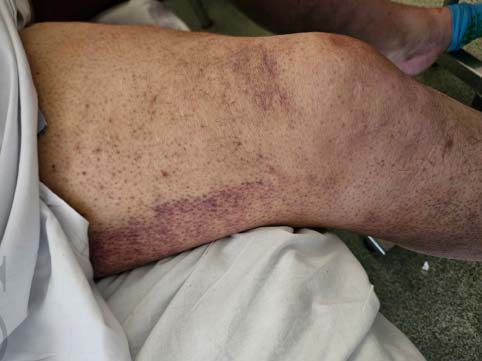
It’s a disease usually associated with seafarers from days gone by.
But an Australian man has been diagnosed with scurvy – and experts say the cost-of-living crisis may partly be to blame for a re-emergence of the disease.
The condition is caused by a vitamin C deficiency.
READ MORE: Cash-strapped Bruce Lehrmann to learn if appeal over defamation loss can go ahead
The man, from Western Australia and aged in his early 50s, had also undergone weight loss surgery.
But he told doctors he couldn’t afford the supplements he was supposed to be taking and had also cut back on fruit and vegetable intake.
Sometimes he skipped meals altogether, doctors said.
His legs were covered with tiny painful red-brown pinpoints, resembling a rash, according to medical publisher BMJ Group.
Blood was also found in his urine and he was anaemic.
Despite various tests, his rash continued to spread while he was in hospital.
“Further questioning revealed that he was short of cash and neglected his diet, eating little in the way of fruit and vegetables,” BMJ Group said.
“He said that he sometimes skipped meals altogether.
“He had also stopped taking the nutritional supplements prescribed for him after previous weight loss surgery, because he said he couldn’t afford them.”
READ MORE: Hundreds of Qantas engineers hold snap strike amid pay dispute
READ MORE: A$AP Rocky to go to trial next year on charges he fired a gun at a former friend
Blood tests showed “no detectable levels of vitamin C,” which led to the diagnosis of scurvy.
BMJ Group said it was a “bleak sign of the times”.
The man was successfully treated with treated with daily vitamin C doses of 1000mg, vitamin D3, folic acid and multivitamin supplements.
If left untreated, scurvy can become fatal.
“Scurvy is still seen as a disease of the past, especially in developed countries,” the authors of the report said.
“The rising cost of living also makes it harder for families to afford good quality nutritious foods, while there have been numerous reports of scurvy arising from complications following bariatric surgery.
“Our patient had multiple risk factors, namely, poor dietary habits, obesity, previous bariatric surgery, use of proton pump inhibitors and low-income status.”
Scurvy was first reported in ancient times.
But during the Renaissance era in the 15th and 16th centuries, it killed sailors at sea who went for long periods without proper nutrition.
Other risk factors for scurvy these days include alcoholism, smoking, eating disorders, low household income, obesity, kidney dialysis and drugs that interfere with vitamin C absorption.
Signs can appear as early as a month after a daily intake of less than 10 mg of vitamin C.
Cases of the disease also surfaced in Australia in 2016.
It was diagnosed in a dozen diabetes patients at Westmead Hospital in Sydney’s west.
links to content on ABC
9News





